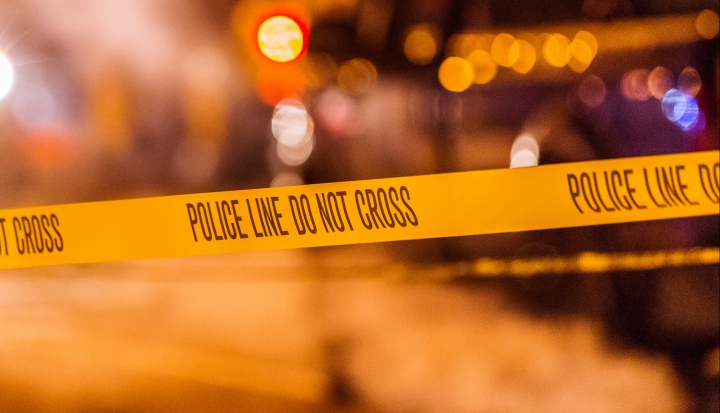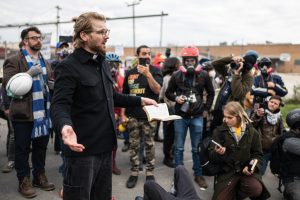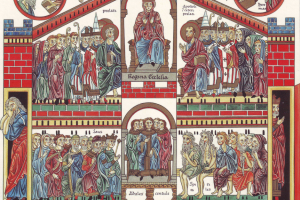In his cramped, sunlit office on the second floor of the Cook County, Illinois Sheriff’s Department, Detective Sergeant Jason Moran keeps an image above the door of St. Michael the Archangel.
A tall, trim man with a military officer’s bearing, Moran has become a kind of avenging angel for families seeking to know what happened to loved ones who went missing and were never found, as well as homicide victims that authorities have been unable to identify.
Moran’s biggest challenge centers on solving one of the greatest mysteries in the annals of crime: determining the names of the still-unidentified victims of notorious 1970s serial killer John Wayne Gacy.
On the wall opposite St. Michael hangs a poster of William George Bundy. A rambunctious 19-year-old, Bundy disappeared in the period when Gacy went on a Chicago-area killing spree that would snuff out the lives of 33 teenage boys and young men. The Gacy case was particularly grisly. He buried many of his victims in a crawl space inside his home in Norwood Park Township, outside of Chicago, dousing some with acid and lime. Most were identified through dental records shortly after Gacy’s arrest. Bundy was among eight victims whose identities remained hidden. He was placed in a grave donated by a Catholic cemetery, marked by a stone with only the date of burial and the words, We remembered.
The Bundy poster holds special significance for Moran. Bundy was the first of the eight unnamed Gacy victims Moran was able to identify—more than 30 years after the teen’s brutal murder.
It was a bittersweet moment for Moran, a detective who defines his work as part law enforcement, part mission, and part ministry.
“I was happy I accomplished what I set out to do, which was to make an ID,” he says. “But in my line of work, accomplishing what I set out to do also causes pain. I had to tell a family that their brother was killed by this evil man.”
Moran’s quest to identify Gacy victims—and others who remain unclaimed and unknown—began in 2011 when Cook County Sheriff Tom Dart made investigating cold cases a priority. He placed Moran, who had successfully identified the remains of a missing person in another high-profile case, in charge of the effort.
“A missing person or murder victim from 40 years ago is no less important than a murder victim today,” Moran says, seated behind a small desk arrayed with his various police badges and cluttered with files on still-open cases.
Most police departments have neither the political will nor the resources to expend on cold cases, he says—a fact cited in a 2011 study by the Rand Center on Quality Policing. “I think that’s a shame,” he says.
The “angel” moniker isn’t one that Moran gives himself. It came from Ruth Rodriguez, the sister of a 22-year-old victim unrelated to the Gacy case. Moran was able to identify Edward Beaudion’s remains through DNA testing after his body was discovered in a forest preserve outside of Chicago, some 30 years after his assailant had hid it there.
Though the news Moran delivered wasn’t what Rodriguez was hoping for, she says it gave her family the chance to finally mourn her brother and provide him with a burial that was “a beautiful tribute.” It was a painful case for Moran as well. Police had identified a suspect in Beaudion’s disappearance years before but without a body could not press charges. When the sheriff’s office identified Beaudion’s remains, Moran moved quickly to make the arrest, only to find the suspect had died just a few months earlier.
Beaudion’s family wanted Edward’s remains to be cremated. Moran arranged for that to happen free of charge. He personally delivered the ashes to the family. “I just felt terrible,” he says. “I didn’t want that family to have to do any more than they had to do.”
Moran grew up under the watchful eyes of an Irish American family on Chicago’s southwest side in a neighborhood populated by police officers and firefighters. Faith and family were the touchstones of his childhood and remain important to him today. “Sympathy and concern for your fellow human beings is something we’re taught as Catholics and it’s something I’m unable to separate from other parts of my life, including my work,” he says.
The detective made the front page of the New York Times last summer when he was able to identify yet another Gacy victim. For 40 years James Byron Haakenson was known only as Victim No. 24. He disappeared in 1976 after he set out from his home in St. Paul, Minnesota for Chicago. He was 16 at the time. In 1978 his body was discovered in Gacy’s residence. For reasons now clouded by time, Cook County law enforcement officers never received Haakenson’s dental records, the main means back then of identifying bodies.
Moran was able to identify both Bundy and Haakenson through advanced DNA testing that did not yet exist in the 1970s. Now DNA samples of homicide victims and any unidentified deceased persons are placed in a national FBI database, but that was not standard practice back then.
“This work has really impressed on me the love of parents for their children, how that never goes away,” Moran, the father of two, says.
“Some parents I have sat with, they care no less now than they did when their loved one went missing. It is something that never fades, the love for a child. And they talk about their child as if these events happened yesterday.”
When Gacy began killing boys and teens, Moran was in preschool. He entered college in the early ’90s, the year Gacy was executed by lethal injection. Little in his background suggested he would one day develop a close bond with Gacy’s victims. To this day he refers to Bundy as “Bill” and Haakenson as “Jimmy.” By contrast, he rarely mentions Gacy by name.
“I have no fascination for the man. He’s an evil killer. I don’t even refer to him by name. In most of my correspondence I refer to him as JWG,” he says.
At a time when mass murders and serial killings were still a shocking rarity in America, Gacy’s killing spree stood out. He strangled or asphyxiated most of his victims, some of whom he lured by posing as a police officer with a phony badge. A pudgy, gregarious man, Gacy was known for his neighborhood parties and was active in politics. In a photo found at his home, he poses with First Lady Rosalynn Carter in May 1978, just seven months before his arrest. He operated a construction company, where he had employed some of his victims, and often dressed as a clown at charity fundraisers for children, earning him the sobriquet, “The Killer Clown.”
“This case really stuck with you,” Moran says. “Women tend to be more vulnerable to crime, but this case taught us you have to watch your boys, too.”
One of Moran’s first moves after taking charge of cold cases was to obtain DNA samples from each of the unidentified Gacy victims. This was no easy task. The unidentified victims were buried in different cemeteries in donated plots. Before they were interred, medical examiners removed each victim’s jawbone, in case dental records eventually turned up. Years passed, and the mandibles too were buried—in a plain wooden box in a section of Homewood Memorial Gardens about 29 miles from Chicago, alongside coffins of the indigent and unclaimed.
When Moran obtained permission to unearth the jawbones, some were too badly decomposed to provide an adequate sample. In those cases, the sheriff’s department had to exhume the bodies to obtain better samples. At the same time, Dart and Moran held a press conference announcing they were reopening the Gacy case. They put the word out on the internet, inviting people whose relatives went missing during the time Gacy was active to come forward and provide DNA samples. All that was needed in most cases was for relatives to provide a saliva swab to determine if their DNA matched that of one of the victims.
That is ultimately how Bundy and Haakenson were identified. In Bundy’s case, however, the key piece of evidence ended up being two canine teeth he had held onto as trophies after they were pulled and that his sister had kept.
In Haakenson’s case, a nephew who wasn’t even born when young Jimmy went missing never stopped looking for clues as to what happened to the uncle he never knew. “It just really bothered me that nobody cared, that somebody went missing and nobody’s doing anything about it,” Jeff Haakenson told the New York Times.
In 2016 Haakenson came across a website for the Cook County Sheriff’s Department that contained information about the Gacy investigation. He filled out a form with his uncle’s name, birth date and last known location. From there, events moved quickly. Moran obtained DNA samples from Jimmy’s older brother and sister. The samples showed they were genetically related to the unidentified Gacy victim. Moran personally delivered the news to the Haakenson family.
“Most families would rather know than not know what happened to their loved one,” Moran says. Most, he adds, express gratitude that a law enforcement official cared enough to keep searching for the truth.
“I have worked some cold cases where I will call a family after 20 years and say, just so you know, I’m still looking at your child’s or your sibling’s death. I don’t know who killed them, but I have submitted the evidence to a lab, I’ve made sure they are in all the modern databases,” Moran says. “And they sit there and say, ‘Really? You still care after 20 years and you’re spending time on this?’ For them, that’s a win because they carry that loved one with them every day.”
Moran says working the Gacy case has made him “hyper-watchful” over his own two children. “I don’t know how much more hyper-vigilant I can be without my wife kicking me out of the house,” he says.
These days, the six remaining unidentified Gacy victims are just as central to his life as his own children. He has been able to identify 12 other victims unrelated to the Gacy case through tips received after the sheriff’s department reopened the Gacy investigation.
Not all the news has been bad. “Five of the missing persons reported to me have been found alive, they were out there alive,” he says, shaking his head in amazement. “And a couple I found dead with death certificates already issued in their name. Their families just didn’t know they passed away. The next of kin was never located.”
Moran says he’ll be disappointed if he is unable to put a name and a narrative to those other six young men’s lives. The 19-year police veteran says he knows it’s a longshot and might not happen before he retires. Still, he says he has put in place a process by which the investigation can continue without him.
“Even if I am not going to be able to identify all of them, I know their cases are contemporary. Their DNA profile is about as good as it’s going to get. It’s in all the modern databases, and it’s going to be there in perpetuity. All the evidence and the documents have been reviewed. And when I retire, there is someone who will have a complete package to go on,” he says.
Until all six are identified, Moran says the infamous Gacy case will be listed as “cleared,” because Gacy was arrested, tried, convicted, and sentenced. But it will not be “closed until all of the victims are identified,” Moran says. “For me, it’s all about closing this case once and for all.”
This article also appears in the May 2018 issue of U.S. Catholic (Vol. 83, No. 5, pages 18–23).
Image: Flickr cc via Tony Webster













Add comment